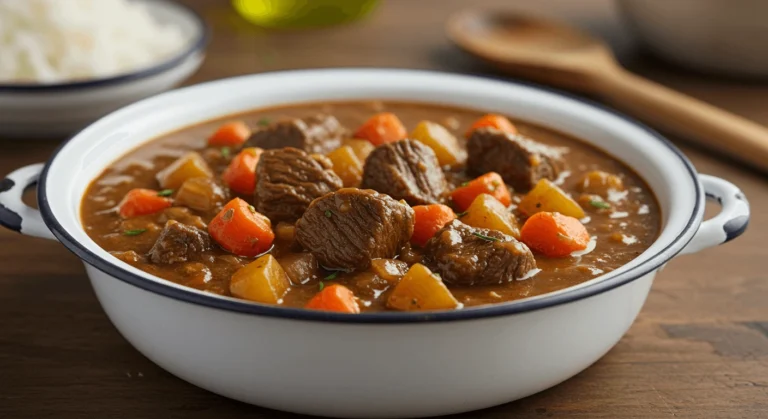
If you’ve struggled with dry, flavorless chicken, you’re not alone. The simple solution? Brining. This technique guarantees juicy, well-seasoned chicken every time. In this guide, you’ll learn the basics of brining, from how it works to easy steps and tips for beginners. Whether you’re roasting a whole chicken or making a quick meal, brining is the key to mouthwatering flavor and tenderness.
Table of Contents
1. What is Brined Chicken?
Brined chicken refers to chicken that has been soaked or coated in a solution of salt, water, and sometimes other ingredients before cooking. This process allows the chicken to absorb moisture and seasoning, leading to a more tender and flavorful result. Unlike marinating, which relies on acid to tenderize, brining uses salt, which changes the protein structure in the meat, helping it to retain moisture during cooking. When done right, brining is a simple and effective way to elevate your chicken dishes.
2. Why Brining Works: The Science Behind the Process
Brining works through the magic of salt and osmosis. When chicken is placed in a salty brine, the salt starts to break down the proteins in the meat, allowing it to absorb water. This absorption not only adds moisture but also helps the chicken retain it during cooking, resulting in a tender, juicy texture.
- Salt and Moisture: The salt in the brine increases the water-holding capacity of the meat. This prevents the chicken from drying out when it’s cooked.
- Flavor Infusion: As the chicken absorbs the brine, it also takes on the flavors of any additional ingredients, like herbs or garlic, infusing each bite with delicious seasoning.
- Tenderization: Brining helps break down the muscle fibers in the meat, making it more tender and enjoyable to eat.
This natural process not only enhances moisture but also means you won’t need to over-season the chicken later, as it’s already packed with flavor.
3. Key Ingredients for a Perfect Brine
A great brine doesn’t require complicated ingredients. Here’s a breakdown of what you’ll need for a basic brine:
| Ingredient | Purpose |
|---|---|
| Salt | Essential for moisture absorption and flavor. |
| Water | The base of a wet brine. Allows salt and flavors to penetrate the chicken. |
| Sugar (optional) | Adds a slight sweetness and helps balance flavors. |
| Aromatics | Herbs, garlic, or spices add extra depth to the chicken’s flavor. |
- Salt: The primary component of any brine, salt is necessary to break down the muscle proteins and help the meat absorb moisture. Aim for about ¼ cup of salt per 4 cups of water.
- Water: Water is the main liquid for wet brining, helping the salt penetrate evenly.
- Sugar: Adding sugar is optional but recommended, as it balances the saltiness and adds a subtle sweetness. Use about ¼ cup per 4 cups of water.
- Aromatics: Ingredients like garlic, bay leaves, or black peppercorns infuse the chicken with additional flavor. Add these to customize the brine to your liking.
4. How to Brine Chicken: Step-by-Step Guide
Brining chicken doesn’t take long, and with the right steps, it can make a noticeable difference in your meals. Here’s a straightforward guide:
Step 1: Prepare the Brine
- In a large container, mix 4 cups of water with ¼ cup of salt and ¼ cup of sugar until they dissolve.
- Add aromatics, such as garlic, herbs, or peppercorns, for added flavor.
Step 2: Submerge the Chicken
- Place the chicken in the brine, making beyond any doubt it’s completely submerged. If you’re using a whole chicken, use a large pot or bowl. For smaller pieces, resealable bags work well.
Step 3: Refrigerate
- Cover the container and refrigerate. Brine times vary depending on the size and cut (more on that below).
Step 4: Rinse and Dry
- Once the brining time is up, remove the chicken, rinse it briefly, and pat it dry to prevent excess saltiness.
Step 5: Cook as Desired
- Your brined chicken is ready to be grilled, baked, or roasted. Enjoy the enhanced flavor and texture.

5. Types of Brines: Wet vs. Dry Brining
There are two main types of brining methods: wet brining and dry brining.
- Wet Brine: This is the traditional method, where the chicken is fully submerged in a saltwater solution. It’s great for whole chickens and results in a deeply flavorful, juicy texture.
- Dry Brine: This method uses salt and seasonings without additional water. The chicken is coated in salt and left to rest in the refrigerator. Dry brining works well for smaller cuts and is convenient if you’re short on space.
| Brining Method | Pros | Cons |
|---|---|---|
| Wet Brine | Adds deep moisture, ideal for whole chicken | Requires more space, extra cleanup |
| Dry Brine | Simple, uses less space, no extra liquid | May require a longer brining time |
Choosing between wet and dry brining depends on the recipe and your preference. Wet brining works well for larger pieces, while dry brining is perfect for smaller cuts or when you want a less involved process.
6. Tips for Beginners
If you’re new to brining, here are a few helpful tips:
- Measure Salt Carefully: Too much salt can make the chicken overly salty, so stick to the recommended amounts.
- Keep an Eye on Time: Brining too long can negatively impact texture. Start with the suggested times, and adjust as you get more familiar with the process.
- Rinse the Chicken After Brining: Rinsing removes excess salt from the surface, preventing the chicken from being too salty.
- Experiment with Flavors: Try different aromatics like rosemary, thyme, or citrus to make the flavor uniquely yours.
7. Brining Times and Recommended Cuts
The ideal brining time varies depending on the cut and size of the chicken. Here’s a quick guide:
| Chicken Cut | Recommended Brining Time |
|---|---|
| Whole Chicken | 4-8 hours |
| Chicken Breasts | 1-2 hours |
| Thighs/Drumsticks | 2-4 hours |
It’s best to start with shorter brining times if you’re new to the technique. You can always extend the time in future attempts based on your preferences.
8. How to Store and Prepare Brined Chicken
After brining, if you’re not cooking the chicken immediately, store it in the refrigerator for up to 24 hours. Make sure it’s covered tightly to avoid cross-contamination.
For cooking preparation:
- Rinse and Pat Dry: Rinse the chicken after brining to remove excess salt, then pat it dry with paper towels.
- Let It Rest: Allow the chicken to rest for 10-15 minutes at room temperature before cooking, so it cooks evenly.
- Avoid Additional Salting: Since brined chicken is already seasoned, use less or no additional salt during cooking.
If you’re planning to freeze the chicken, you can freeze it directly after brining. Thaw in the refrigerator and pat dry before cooking.
9. FAQs About Brined Chicken
What’s the ideal brining time for a whole chicken? For best results, brine a whole chicken for 4 to 8 hours.
Can I use table salt for brining? Yes, but reduce the amount since table salt is finer than kosher or sea salt. Start with about half the usual amount.
Do I require to refrigerate the chicken whereas brining? Yes, refrigerating while brining is essential to keep the chicken safe and fresh.
How do I make brined chicken less salty? Rinse the chicken well after brining to remove excess salt from the surface.
Can I add vinegar or lemon juice to the brine? Yes, adding a small amount of acid can enhance flavor, but too much may toughen the chicken.
10. Nutrition Facts (per serving)
Here’s a general idea of the nutrition in a serving of brined chicken, though values may vary:
| Nutrient | Amount |
|---|---|
| Calories | 250 kcal |
| Protein | 25 g |
| Fat | 10 g |
| Sodium | 800 mg |
| Carbohydrates | 2 g |
11. Similar Recipes to Try
If you enjoyed learning about brining, here are other chicken recipes that use similar techniques:
- Buttermilk Marinated Chicken: Adds a tangy depth to the flavor.
- Herb-Crusted Roast Chicken: Coated with fresh herbs and spices.
- Lemon Garlic Chicken: Pairs well with the tenderness from brining and a burst of citrus flavor.
Conclusion
Mastering the art of brining can be a game-changer in the kitchen, allowing you to elevate the flavor and texture of chicken effortlessly. From whole roast chicken to tender drumsticks, brining unlocks juiciness and depth of flavor you won’t get with other methods. Give it a try, explore different flavors, and find the perfect brine for your tastes. If this guide helped you, share your favorite brining tips in the comments, and don’t forget to try our similar recipes. Enjoy your perfectly brined chicken and happy cooking!
Share Your Experience
There are no reviews yet. Be the first one to write one.



